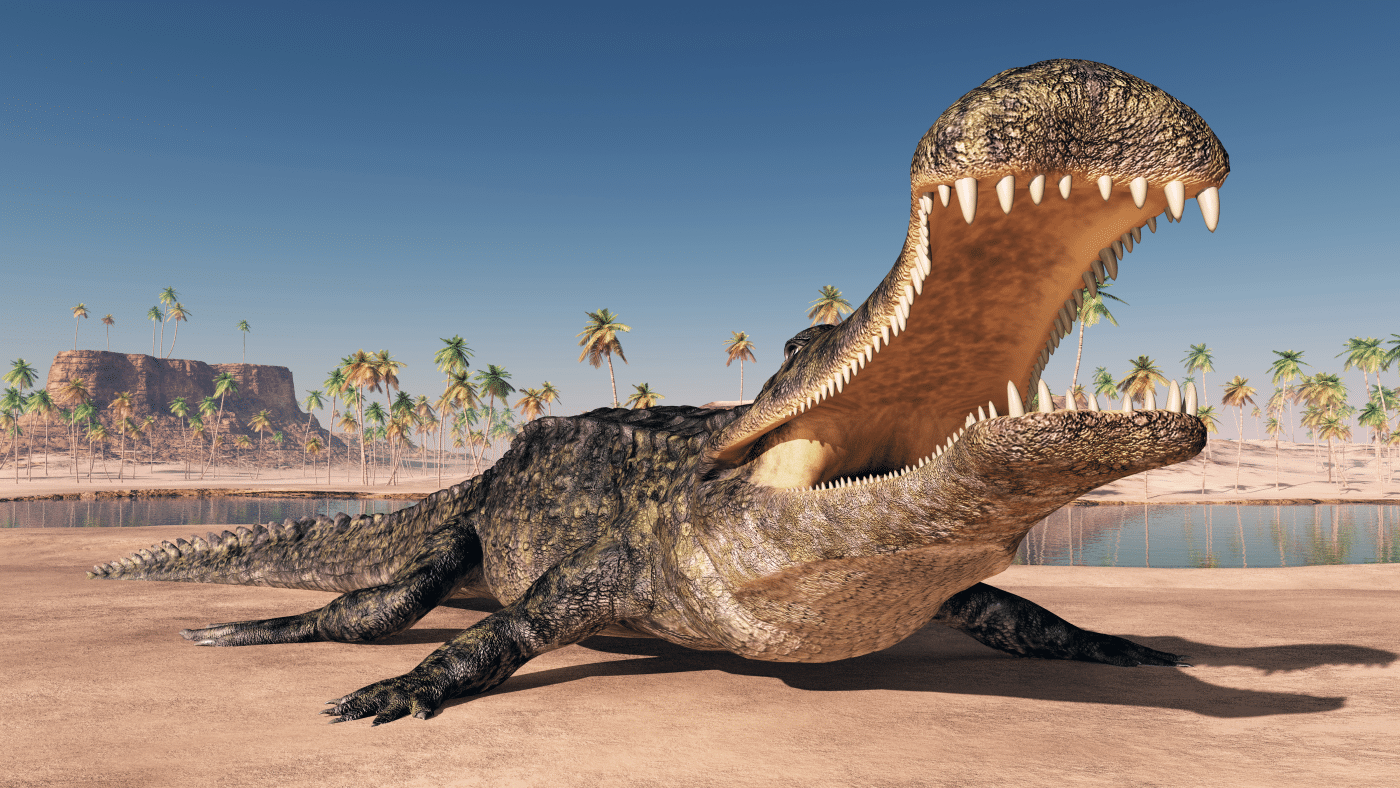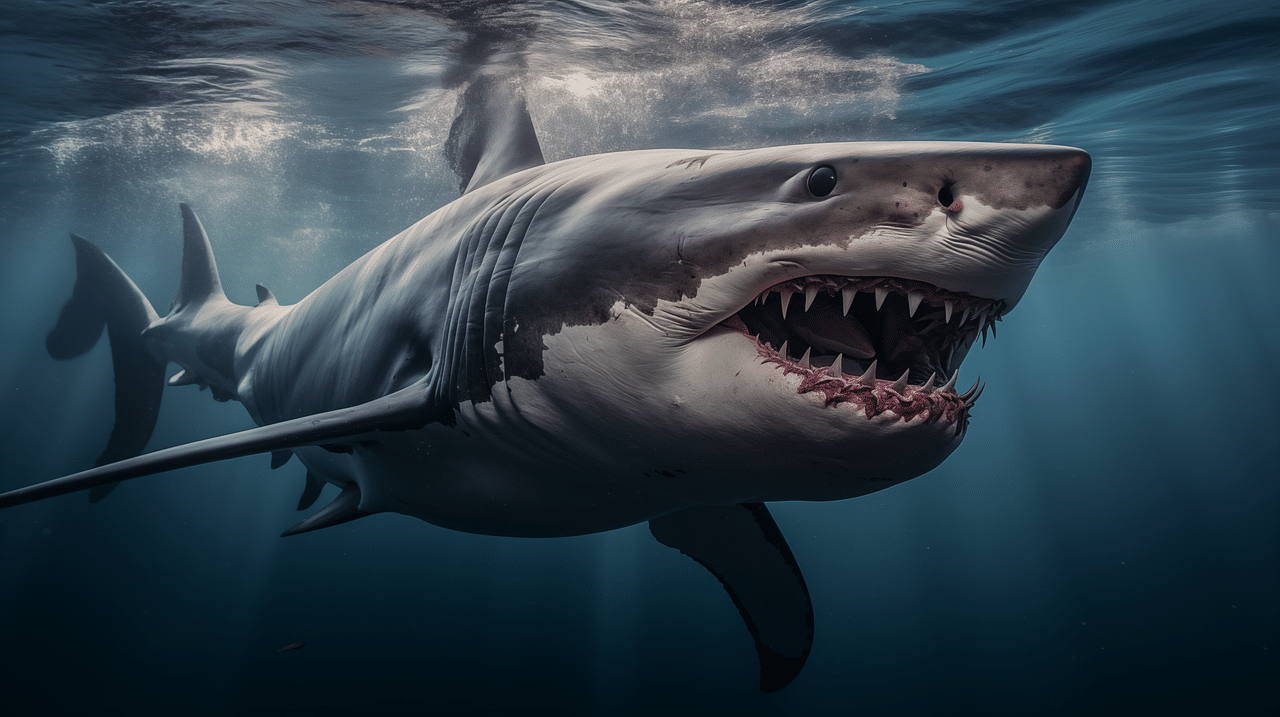 Shutterstock
Shutterstock
Throughout the history of life on Earth, some creatures have been so large, so dangerous, or so terrifying that just imagining an encounter with them is enough to send chills down your spine. While most of these horrific beasts are long extinct, their sheer size and ferocity make them the stuff of nightmares. From massive prehistoric sharks to terrifying marine reptiles, these creatures ruled the Earth for millions of years before eventually fading into the annals of history. Here are 12 horrifying creatures you should be glad are extinct.
Megalodon
 Shutterstock
Shutterstock
The Megalodon is perhaps the most famous extinct creature that continues to haunt our imaginations. This ancient shark was a true monster of the deep, with an estimated length of up to 60 feet, far larger than today’s largest sharks, like the great white. Its teeth, each over 7 inches long, were designed for slicing through meat, and it likely hunted whales, large fish, and other marine mammals. If this beast were still around today, swimming in the oceans would be a much riskier proposition. Just the thought of a 60-foot predator patrolling the waters would keep anyone out of the sea. Thankfully, this prehistoric terror has been extinct for millions of years, and you can swim without worrying about being gulped down in one terrifying bite.
Titanoboa
 Shutterstock
Shutterstock
Imagine coming face-to-face with a snake so large that it could wrap itself around an entire bus. The Titanoboa, the largest snake ever known to have existed, lived around 60 million years ago and reached lengths of over 42 feet. Weighing nearly a ton, Titanoboa would have easily dominated its environment. This gigantic snake was an apex predator, able to constrict and crush anything unfortunate enough to come too close. With a diet likely consisting of crocodiles and large fish, the Titanoboa was not an animal you’d want to encounter in the wild. Thank goodness these snakes are long gone — if they still roamed jungles today, even the bravest adventurer would think twice about trekking through snake territory.
Argentinosaurus
 Shutterstock
Shutterstock
One of the largest land animals to ever live, the Argentinosaurus was a sauropod dinosaur that could reach lengths of over 100 feet and weigh up to 100 tons. This herbivorous giant would have been a terrifying sight to behold if you could ever manage to spot one through the dense foliage of its time. Its immense size made it nearly invincible to predators, and it likely used its long neck to reach the tops of trees and feed on vegetation. While the Argentinosaurus wasn’t a threat to humans (because, let’s face it, humans didn’t even exist back then), the sheer scale of these dinosaurs would make them an awe-inspiring, yet intimidating, sight in any era. Imagine a creature so huge that its footsteps would shake the earth beneath you.
Andrewsarchus
 Shutterstock
Shutterstock
Looking like a cross between a wolf and a hyena, the Andrewsarchus was a hypercarnivore that lived around 45 million years ago. It was the largest carnivorous mammal of its time, standing nearly 6 feet tall at the shoulder and possessing sharp teeth perfect for tearing into meat. With a long, powerful jaw and a predatory instinct, Andrewsarchus likely stalked its prey through the ancient forests. Though it is now extinct, just the thought of a giant, meat-eating mammal wandering the land would have made any prehistoric creature think twice about crossing its path.
Therizinosaurus
 Shutterstock
Shutterstock
While many dinosaurs were fearsome predators, the Therizinosaurus was a bizarre herbivore with a terrifying weapon: massive claws that could grow up to 10 feet in length. Though this dinosaur didn’t hunt other animals, it would have been a creature no one would want to mess with. The Therizinosaurus likely used its claws for defense and possibly to gather vegetation, but its size and long, sharp claws would have made it a formidable presence in the Cretaceous period. Imagine the shock of encountering a creature that seemed more like a nightmare straight out of a sci-fi movie, with those giant claws waving in the air.
Helicoprion
 Shutterstock
Shutterstock
The Helicoprion was a prehistoric shark-like fish that lived over 290 million years ago, and it’s best known for its highly unusual and terrifying spiral teeth. These teeth, resembling a buzzsaw, were used to slice through prey with alarming efficiency. The Helicoprion’s bizarre mouth and unusual tooth structure made it look more like a deep-sea monster than a typical fish. If you found yourself swimming near one of these terrifying creatures, you would have a hard time escaping its deadly jaws. Thankfully, the Helicoprion is long extinct, but its freaky teeth and jawline still leave paleontologists scratching their heads in wonder.
Indricotherium
 Shutterstock
Shutterstock
Also known as Paraceratherium, the Indricotherium was a massive herbivorous mammal that roamed Earth around 34 million years ago. Standing over 16 feet tall at the shoulder and weighing up to 20 tons, this colossal mammal would have dwarfed any modern land animal. The Indricotherium wasn’t a predator, but its size would have made it an imposing and terrifying presence in the ancient landscape. It likely used its bulk to push through dense vegetation and reach the higher branches of trees. Though herbivorous, the sheer scale of the Indricotherium would have been enough to intimidate even the largest predators of the time.
Spinosaurus
 Shutterstock
Shutterstock
The Spinosaurus is famous for being one of the largest, most fearsome predators to ever walk the Earth. Growing up to 50 feet long, this dinosaur had a massive sail-like structure on its back that made it look even more menacing. Unlike most other large carnivores of its time, the Spinosaurus was primarily aquatic and hunted both in water and on land. Its crocodile-like snout and sharp teeth made it a terrifying predator capable of hunting large fish, other dinosaurs, and possibly even large aquatic creatures. If Spinosaurus were still alive today, it would be an apex predator like no other, one that would strike fear in anyone who ventured into its domain.
Dakosaurus
 Shutterstock
Shutterstock
This ancient marine reptile, which lived during the Late Jurassic period, was a true sea monster. The Dakosaurus resembled a giant, crocodile-like creature, but it was much more streamlined and built for speed in the water. With a powerful set of jaws and sharp, serrated teeth, it was capable of hunting other marine reptiles, fish, and anything that swam too close. At up to 20 feet long, the Dakosaurus was an apex predator in the ancient oceans. Its appearance in the water would have been a horrifying sight, and the idea of encountering such a creature while swimming would certainly put anyone off the idea of beach vacations.
Terror Birds
 Shutterstock
Shutterstock
These flightless birds, which lived in South America during the Cenozoic era, were terrifying predators that could stand over 10 feet tall. With massive, sharp beaks and powerful legs, Terror Birds were perfectly equipped to hunt smaller mammals, birds, and anything that came within range. These birds were fast, strong, and could easily overpower prey. The thought of a giant, beak-wielding bird chasing you down is enough to make anyone fear the skies. These birds were truly apex predators, and if they were still around today, you’d definitely want to stay on the ground!
Sarcosuchus
 Shutterstock
Shutterstock
The Sarcosuchus, also known as “Super Croc,” was a massive ancient crocodile-like reptile that lived during the Cretaceous period. Growing up to 40 feet long and with a jaw full of teeth, this creature was a terrifying predator in both water and on land. Its massive size and crushing bite made it capable of hunting just about anything that dared to enter its domain. The idea of encountering one of these monsters near the water would be a true nightmare. Fortunately, this ancient giant is long extinct, leaving only its fossilized remains behind.
Liopleurodon
 Shutterstock
Shutterstock
The Liopleurodon was a formidable marine reptile that lived during the Late Jurassic period. With a long, powerful body and a mouth full of razor-sharp teeth, it was a true terror of the ancient seas. Reaching lengths of up to 25 feet, the Liopleurodon was an apex predator capable of outswimming and outmaneuvering most other marine creatures. Its terrifying jaws and hunting efficiency made it a nightmare for any creature unlucky enough to cross its path in the water. The ocean would have been a much scarier place with these predators still patrolling the depths.
The Creatures That Should Have Stayed In The Past
 Shutterstock
Shutterstock
The creatures of the past were often larger, scarier, and far more dangerous than anything we encounter today. These extinct animals would have made modern life feel like a constant battle for survival. Thankfully, they’re now relegated to the history books, and we can only appreciate them through fossils. Still, their legacy endures in nightmares, fossils, and horror movies. So, the next time you go for a swim or hike, be thankful these terrifying creatures are long gone — unless, of course, you run into a bear!
 Toledo, United States.
Toledo, United States.